This post is adapted from the blog of Datafiniti, a Priceonomics Data Studio customer. Does your company have interesting data? Become a Priceonomics customer.
***
“I was a hardcore vegan for fifteen years. I’ve even done raw,” wrote Outkast’s André 3000 in 2014. “But socially it became horrible. I was kind of just sitting at home eating a salad.”
The rapper’s complaint hits on one of the worst drawbacks of being vegetarian or vegan: when you’re planning a night out with friends, it can be hard to find restaurants that cater to your diet.
But in some cities it’s easier than others.
We wanted to figure out which cities are the best for vegetarian eating, so we turned to the data of Priceonomics customer Datafiniti. Datafiniti maintains datasets on everything from hotel occupancy to pricing for designer brands. For this analysis, we used a dataset of more than 18,000 U.S. restaurants that either self-identify as offering vegetarian or vegan cuisine, or which have “vegetarian” or “vegan” in their names.
We found that big metro areas offer the most vegetarian- and vegan-friendly restaurants in absolute terms. But when we looked at vegetarian and vegan restaurants per capita, small western cities and college towns are the most welcoming to those who don’t eat meat. Among large metros, Portland, San Francisco, and Seattle consistently rank at the top of the list. If you want to eat out and not eat meat, there is no better place to be than the Pacific Northwest and Northern California
***
We began our analysis by tallying up the number of veg-friendly restaurants in each of the nearly 400 metropolitan statistical areas in the U.S.. The following table displays the 50 metro areas with the most options.
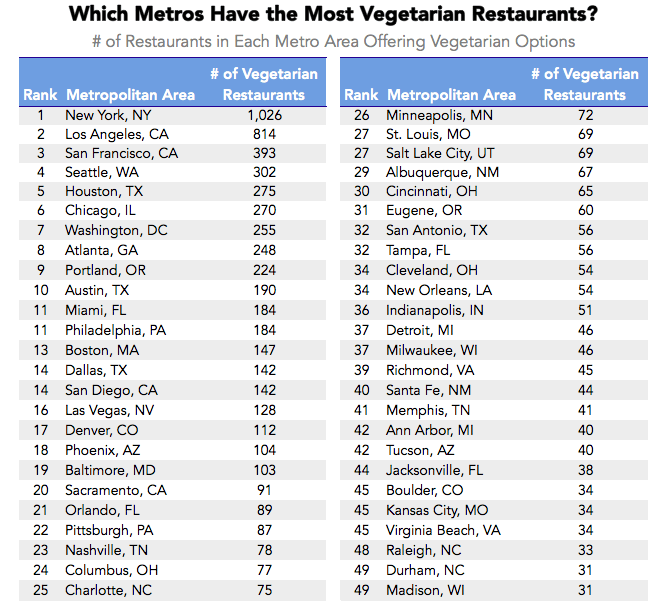
Data source: Datafiniti
This ranking resembles a list of the largest metro areas, which makes sense. More people means more vegetarians and more vegetarians means greater demand for vegetarian-friendly eateries. Large cities are also better able to cater to niche markets than are small cities.
But there are some exceptions. First, Chicago and Dallas—known for meat-centric regional cuisines like brats and barbecue—rank 3rd and 4th in population size, but 6th and 14th in number of vegetarian restaurants. Conversely, notably liberal cities like San Francisco, Seattle, Portland, and Austin, which don’t break the top 15 in terms of size, all fall in the top ten when it comes to vegetarian options.
But how many diners share these options? Having hundreds of vegetarian restaurants to choose from could be great, but not if you’re competing with millions to snag a table.
To find the big cities where herbivores share the greatest number of restaurants, we scaled the number of vegetarian restaurants in each of the 25 largest metro areas to the size of its population. We rank the 25 metropolitan areas with the most and least vegetarian restaurants per 100,000 residents below.
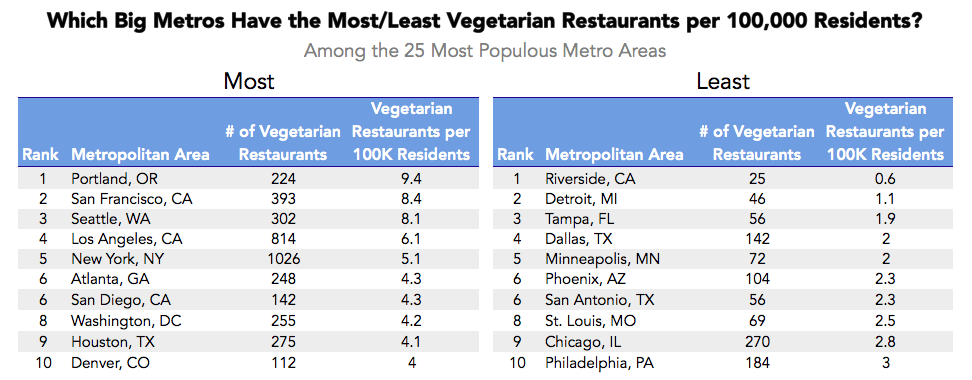
Data source: Datafiniti
When population is taken into account, smaller metropolitan areas with a relative wealth of vegetarian restaurants climb to the top of the ranking: Portland, San Francisco, and Seattle offer upwards of eight vegetarian-friendly restaurants per 100,000 residents. West Coast cities in general make a strong showing in this ranking, accounting for half of the top ten entries. Meanwhile, inland cities like St. Louis, Dallas, and Detroit fill out the list of cities with the fewest vegetarian options.
This ranking is limited to the top 25 metro areas by population size, but what if we open this analysis up to smaller cities?
Here, we rank metropolitan areas by the number of vegetarian restaurants they offer per 100,000 residents. This time, we include metropolitan areas of any size, provided they have at least ten vegetarian restaurants.
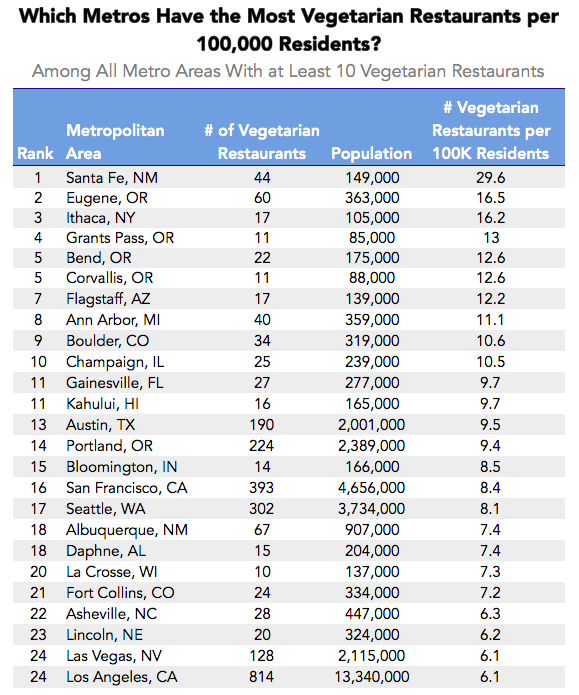
Data source: Datafiniti
Only four of the largest 25 metro areas – San Francisco, Los Angeles, Portland, and Seattle – make it into our ranking of all metro areas. Instead, this list is dominated by small western cities and college towns. All but eight cities are located west of the Mississippi, and eleven of the 25—including seven (Eugene, Corvallis, Flagstaff, Ann Arbor, Boulder, Champaign, and Ithaca) of the top ten—are listed among the best college towns in America. Santa Fe, which takes the top spot, offers an impressive total of nearly 30 vegetarian restaurants per 100,000 residents.
***
We next sought out the most vegan-friendly cities. With a diet that excludes animal products like eggs and milk, vegans are likely to face greater challenges than vegetarians when it comes to finding diet-compatible restaurants. Are the cities that accommodate vegetarians similarly accessible to vegans?
To find out, we filtered our dataset to include only restaurants that self-identified as offering vegan cuisine, or which have “vegan” in their names. We then counted the number of vegan eateries falling into each metro area, and ranked them accordingly. The top 50 are shown below.

Data source: Datafiniti
Our ranking shows that cities that cater to vegetarians generally cater to vegans as well: 46 of 50 cities appear on both lists. But those cities have roughly half as many vegan options.
Dayton, OH; Bend, OR; Albany, NY; and Allentown, PA are the lone cities that rank among the top cities for vegans, but not vegetarians.
Next, we wanted to single out which of the 25 biggest cities serve the market most and least well.
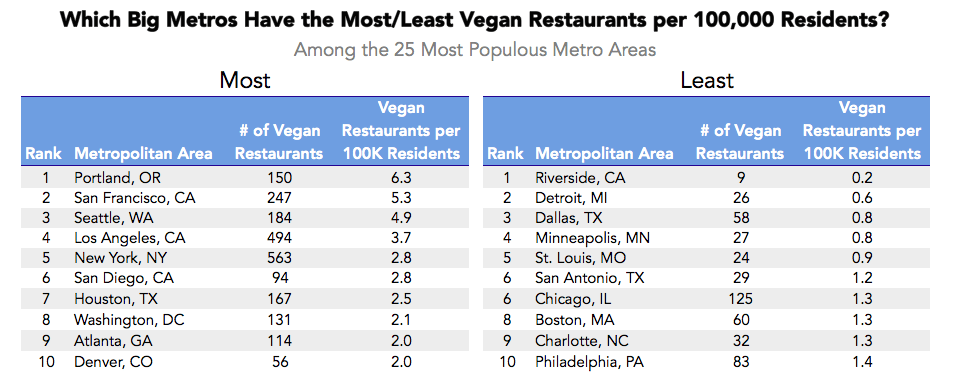
Data source: Datafiniti
Vegans living in Portland, San Francisco, and Seattle are substantially better off than the average person living in a big metro area. These cities each boast double the number of vegan-friendly restaurants as the average city.
There is a great deal of similarity between the vegetarian and vegan restaurant rankings. In fact, the top five metro areas on each list were identical. Vegans and vegetarians alike will dine well in Portland, San Francisco, Seattle, Los Angeles, and New York.
We were also interested to see whether the pool of all cities – including smaller metros like Santa Fe, NM and Eugene, OR, which dominated the vegetarian rankings – would more readily accommodate vegans as well. We again opened our ranking up to all metro areas, irrespective of population size, provided they had at least ten vegan restaurants. The top 25 are shown below.
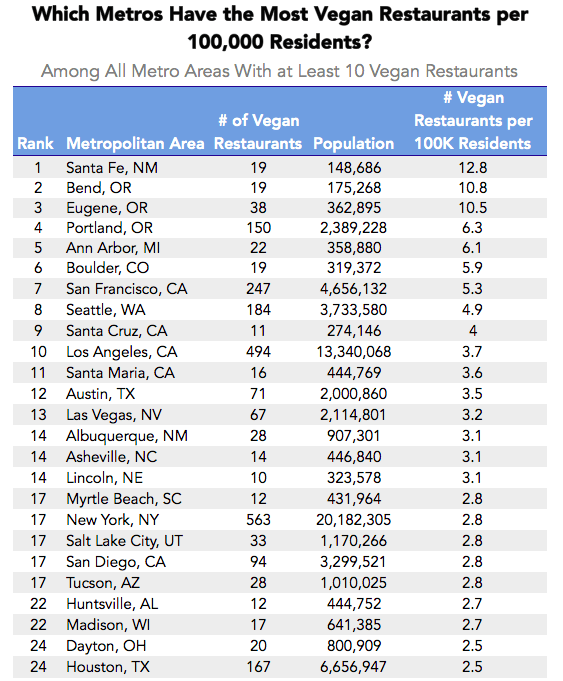
Data source: Datafiniti
With respect to their dining options, vegan residents of these smaller cities are somewhat better off than those living in the largest metro areas. They share an average of 4.6 restaurants per every 100,000 residents, compared to two for residents of the largest cities. Santa Fe again seized the top spot, with an impressive 12.8 restaurants per 100,000 residents.
While the rankings of vegetarian and vegan restaurants were quite similar when we considered the absolute number of eateries, some disparities emerged when we factored in population size. Ithaca, NY; Flagstaff, AZ; Grant’s Pass, OR; Corvallis, OR; and Champaign, IL ranked in the top ten for vegetarian restaurants per 100,000 residents, but are nowhere to be seen in the vegan ranking. These cities are more accommodating to their vegetarian residents than their vegans.
***
Finally, we wanted to find out which cuisines are most often served at vegetarian-friendly restaurants. When they eat out, are vegetarians more likely to be dining on hummus and pita or pasta e fagioli?
To find out, we grouped the vegetarian restaurants in our sample by self-proclaimed cuisine. We express the size of each group below as a percent of all vegetarian restaurants in our sample.
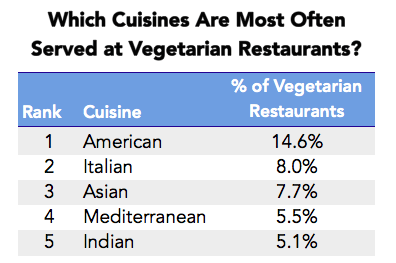
Data source: Datafiniti
The top spot in our ranking goes to “American” cuisine, which includes places that primarily offer soups, salads, and sandwiches—in other words, fare that is easily made vegetarian-friendly. Similarly, managers of Italian and Asian restaurants, which are 2nd place respectively, have learned that pasta-heavy menus can easily be marketed as “vegetarian.”
***
Our analysis shows that while big cities have the most vegetarian-friendly restaurants, vegetarians and vegans in mid-size metro areas like Portland and Seattle, or small, liberal cities like Santa Fe and Ithaca, may be better off. They are likely to face the least competition when it comes to finding a table at their cities’ vegetarian eateries.
So when André 3000 bemoaned the social consequences of his animal-free diet, that may be because he was operating out of Atlanta, a city with only two vegan restaurants per 100,000 residents. Had he been living in veg-friendly Santa Fe, he might have sung a different tune.
Our next article explores the role insurance markets could play in reducing police on civilian violence. To get notified when we post it → join our email list.
![]()
Announcement: The Priceonomics Content Marketing Conference is on November 1 in San Francisco. Join speakers from Andreessen Horowitz, Slack, Thumbtack, Priceonomics and more.
Get your ticket here.




